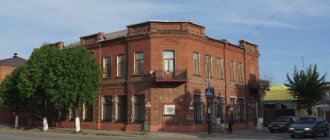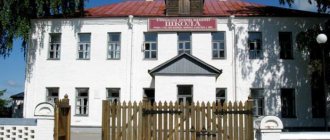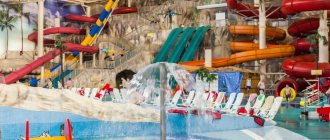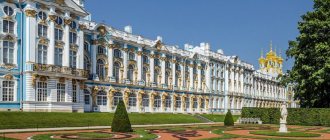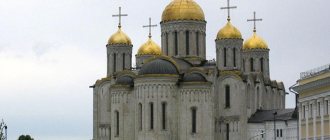Mikhaylov
Sights of Mikhailov
The best place to start getting to know Mikhailov is from the historical center - Marshal Golikov Street. history museum
is located here .
It features exhibitions dedicated to the ancient history of the city, the Middle Ages, the Great Patriotic War and the Soviet period.
Nearby at the intersection with Pronskaya Street on Red (formerly Cathedral) Square you can see a memorial sign. Archangel Cathedral stood here from the 16th to the 20th centuries.
.
Over its four-hundred-year history, it was rebuilt several times, the last time this happened at the end of the 19th century, when the temple was rebuilt according to the design of the architect K. Ton.
However, in 1936 the cathedral was demolished; today its model can be seen in the local history museum. Currently, work is underway to restore the temple.
Literally a few steps from the square there is an architectural monument of the 18th century - Tax Izba
.
Initially, the treasury was located here, where taxes were collected, then the building changed owners several times and today belongs to the museum, which is raising funds for its restoration.
Nearby in the park on Cathedral Hill there is a monument to Archangel Michael
, the heavenly patron of the city.
This is the work of sculptor Oleg Sedov. Across the road you can see another monument - a memorial to those who fell in the Great Patriotic War and a T-34 tank
.
This is a real fighting vehicle that took part in the battles of Prokhorovka, in the battles for the liberation of Prague and in the storming of Berlin. By the way, the monument offers a magnificent view of Mikhailov.
Another attraction of the city center is the bridge over the Pronya River
. It was built in 1898 according to the design of the architect A. Bantle.
It is notable because it is riveted and constructed from large metal parts. In addition, traces of shells from the Great Patriotic War period remained on its supports. Currently the bridge is pedestrian.
The Church of the Nativity of the Virgin Mary is also noteworthy.
- an architectural monument of federal significance. Built at the end of the 18th century, it was originally part of the Nativity of the Mother of God Monastery, which was later abolished.
During the years of Soviet power it was closed and used as a salt warehouse; at the end of the 20th century it was handed over to believers.
Next door on Pronskaya Street there is a former district zemstvo building
, and currently it houses the city administration. The construction dates back to 1912, the architect is A. Bantle.
This is a striking example of provincial modernism; on the walls of the building you can see the Mikhailov coat of arms and other decorative elements.
Not far from here, on the banks of the Leshchinsky stream, there is the “Blue Mountain” settlement.
- archaeological monument of the 12th-14th centuries. In this place there was a settlement of the Vyatichi Slavs before it was plundered by the Mongol-Tatar hordes. Archaeological finds from the settlement can be seen in the local history museum.
A few kilometers from Mikhailov there is another interesting place - the Intercession Convent
. It was founded in 1507 near Ryazan (now in that place the village of Agro-Pustyn), and in 1819 it was moved to Mikhailov. In the 20th century, the monastery was completely destroyed; its restoration is currently underway.
Another monument of religious architecture is the Church of the Nativity of Christ
on Prudskaya street. The temple on this site existed for a long time, and at the turn of the 18th and 19th centuries it was rebuilt in stone in the provincial Baroque style.
It was not closed under Soviet rule, which is why it is well preserved. Today it is the cathedral of the Ryazan and St. Michael's diocese.
There is another interesting place on Truzhenits Street - the Mikhailovsky Lace Museum
. Here you can see both the works of local craftswomen and samples of bobbins from different countries.
In addition, guests are invited to take part in lace-making workshops. The museum operates at the Mikhailovskaya Lacemaker factory, which continues the traditions of the local unique artistic craft.
In the Mikhailovsky district on the banks of the Lubyanka River there is a unique monument - the Lubyanskoye ancient settlement
, striking in its size. Here in ancient times stood a city that perished in 1237 during the invasion of Batu. It has not yet been possible to establish what kind of city this was, but it is believed that this is the famous chronicle Belgorod.
Another ancient settlement - Izheslavl
— is located on the banks of the Prony River near the village of the same name. It is believed, but not proven, that the ancient Izheslavets stood on this site, destroyed by Batu.
The settlement is notable for its three rows of ramparts and ditches, which indicates the reliable fortification of the city, which, unfortunately, did not save it from ruin. In addition to being historical, the place has natural value: many rare plants grow here.
Not far from the village of Krasnaya Gorka, Mikhailovsky district, you can see the beautiful estate of A.P. Ermolov
, one of the favorites of Catherine II. Of the buildings here, the Kazan Church, the round barnyard and the manor house itself have been preserved, but its interior decoration has been lost.
Now the estate is part of the courtyard of the Sretensky Monastery, so access to it is limited.
There is another ancient estate in the Mikhailovsky district, which, unfortunately, is in ruins. This is the estate of landowner Gagarin
, located in the village of the Central Branch of the State Farm named after. Ilyich.
Two outbuildings, the ruins of a church and stables have survived to this day. The manor house itself was lost; it housed a school until the end of the 20th century; after its closure, the building was dismantled. The distillery that previously operated here has also been lost, but the alcohol storage facility has been preserved.
The largest cities in the Ryazan region by population
There are only 12 cities in the Ryazan region. There are no millionaires among them, and the capital of the region, Ryazan, boasts only 538,962 residents. Next in the ranking of the largest settlements in the region is the small town of Kasimov, where 17 times fewer people live: 30,696. In another 7 cities, the number of inhabitants ranges from 10,340 to 26,329, and in the smallest, Spassk-Ryazansky, which closes the ranking, only 6,555 live. Because of this imbalance, the region risks becoming monocentric, since almost half of the population lives in the capital, which is why the remaining settlements practically do not develop.
There are also 21 urban-type settlements. Interestingly, three of them have more inhabitants than cities. These include:
- Shilovo - 14,531;
- Lesnoy - 7,687;
- Tuma - 5,899.
List of the most populous cities in the Ryazan region:
- Ryazan - 538 962.
- Kasimov - 30,696.
- Skopin - 26,329.
- Sasovo - 25,747.
- Ryazhsk - 21,623.
- Rybnoye - 19,265.
- Novomichurinsk - 16,852.
- Korablino - 11,272.
- Mikhailov - 10,340.
- Spassk-Ryazansky - 6,555.
Theater
So Alexander Mikhailov, instead of the Higher Naval School, ended up at the Far Eastern Pedagogical Institute of Arts at the theater department, choosing the specialty “Theater and Film Actor”. In 1969, he received a diploma of higher education and was accepted into the troupe of the Primorsky Regional Drama Theater named after Gorky in the city of Vladivostok.
In 1970, he left for Saratov, where he played in the drama theater for nine years.
In 1979, he was invited to Moscow to the Ermolova Theater, where he worked for six years.
From 1985 to 2004, Mikhailov appeared on the stage of the Maly Theater.
In his theatrical career, the most famous characters whom Alexander played superbly:
- Raskolnikov in "Crime and Punishment";
- Prince Myshkin in “The Idiot”;
- Vershinin in “Three Sisters”;
- Konstantin in “Children of Vanyushin”;
- Jamie in Y. O'Neill's production of "Long Day's Journey into Night";
- Doctor Dorn in Chekhov's "The Seagull";
- Shamanov in the play “Last Summer in Chulimsk”;
- Astrov in "Uncle Vanya";
- Hector in Heartbreak House;
- Ermakov in the production of “Battalions Ask for Fire.”
Skopin - the city is developing towards tourism
The third place in the ranking is occupied by Skopin, where there are 4,000 fewer residents than in Kasimov. This is a small provincial town with a density of only 852.07, so the problems of megacities or even large regional centers are unusual for it. It has the status of a city of regional significance, to which 5 other settlements are subordinate, but the buildings here are predominantly low-rise or private.
There are two large enterprises here that shape the city’s economy and provide the local population with jobs: the Mining Equipment Plant and the Automotive Aggregate Plant, the largest manufacturer of automotive components in Russia. It existed for a long time, causing irreparable harm to the ecology of the region. During its existence, about 1.5 tons of waste were buried in burial grounds near Skopin, which contained approximately 200 billion doses of toxic arsenic, lethal to any person. The settlement is an important transport hub: the Caspian highway and railway lines of federal significance serve strong passenger and cargo flows. Skopin is also known as the center of Russian pottery, which attracts tourists from all over the country. Thanks to the development of tourism infrastructure, since 2022 there has been an increase in the number of city guests who want to get acquainted with its historical past and folk crafts.
Ryazan is large by Russian standards
Despite the lack of million-plus status, by the standards of the country Ryazan is a fairly large populated area. 538,962 people live here, which puts it among the thirty largest in the Russian Federation. The density is average compared to other regional centers, but, of course, does not reach the capital:
- Ryazan - 2,406;
- Lipetsk - 1543.95;
- Tula - 3311.89;
- Moscow - 4925.19.
The first settlements here appeared in the Paleolithic era, and the modern city of Ryazan was founded in 1095. Despite the significant contribution of the settlement to the history of the country and its changing population over time, it could not be called large: by 1811, only 7,800 people lived here. The peak increase in the number of city residents occurred during the Soviet years: from 49,100 people in 1913, the figure reached 527,000 in 1991. Ryazan is the industrial center of the region, accounting for 60% of production. The most important industrial facility is a large oil refinery. The capital of the region is home to representative offices of many Russian and foreign companies and higher educational institutions. The Ryazan transport hub connects the Urals and Moscow, which ensures high traffic, including heavy trucks.
On the central streets of the city, due to the lack of dedicated lanes and improper parking, traffic jams are regularly observed, which increase significantly in the summer, when many tourists come to the ancient city. In addition, the presence of a large Ryazan agglomeration plays a rather significant role in the formation of congestion on exits from the city and the creation of a feeling of crowdedness in the center. Every day, thousands of residents of the suburbs, where the environment is better and housing is cheaper, go to work in the regional center, increasing its number several times during the daytime. All this creates a negative environmental situation, the main “contribution” to which is made by exhaust gases. In second place are emissions from industrial enterprises.
Childhood and youth
Stanislav was born on April 27, 1969 in the city of Sochi. The Mikhailov family was not rich: father Vladimir Borisovich served as a civilian helicopter pilot. The man comes from the ancient city of Shemakha and has Azerbaijani roots. Mother Lyudmila Vasilievna worked as a nurse.
The future singer spent his childhood on the sunny shore of the Black Sea in a friendly circle of relatives. Stas was greatly influenced by his older brother Valery, who taught Mikhailov the first chords on the guitar and inspired him to become a pilot.
View this post on Instagram
A post shared by Stas Mihailov (@stas_mihailoff)
Stas Mikhailov in childhood with his older brother
After graduating from school, Stanislav went to Minsk to continue the family business and devote his life to the sky. The young man entered the civil aviation school, but 7 months were enough to give up on this dream. Stas left school and returned home. In Adler, he found work as a loader in a store. Mikhailov was ashamed of the craft and tried in every possible way to avoid acquaintances who might see a southerner doing such an activity.
Then Stas was drafted into the army. The singer was sent to Rostov-on-Don, where he served in the Air Force of the North Caucasus District. Thanks to his experience, Mikhailov was appointed driver at headquarters.
After the army, Stas returned to his hometown, where the artist’s creative biography began. Mikhailov became a businessman, worked part-time in a recording studio, and sang in restaurants in the evenings. The last 2 jobs gave the future star the opportunity to at least briefly look into the world of show business. Stanislav soon became a local celebrity, and this popularity pushed the soloist to take up music seriously.
Personal life
Mikhailov's first wife was his classmate Vera Musatova. In this marriage, a boy, Konstantin, was born in 1969. At the age of 19, Kostya became the champion of Russia in breakdancing. Then he studied at the Moscow Art Theater School and graduated from directing courses at VGIK, worked as a presenter on Channel One, TVC, and Zvezda. Currently working on radio, he has received many awards as “Best Radio Presenter in Russia.”
In 2003, Alexander officially married for the second time to the widow of actor Vladimir Vasiliev. The woman’s name is Oksana, from her first marriage she has a son, Vlad, Mikhailov adopted him. In 2002, Alexander and Oksana had a girl, Akilina.
Alexander also has an illegitimate daughter, Anastasia, she was born by theater actress Olga Kuznetsova, who had a fleeting affair with Mikhailov.
Dreams of the sea come true
Dreams of the sea never left Mikhailov; he re-read all the works of Jack London. He had not just love for this element, but a fanatical passion. Mom saw this and deep down understood that she could not change anything. But still she tried to accustom her son to other hobbies. She sang wonderfully herself and wanted to introduce Sasha to music, bought him a Tula harmonica, and after half a month he exchanged it for a vest. His mother gave him a good time then. Then she gave her son a Smena-2 camera, but it soon turned out to be exchanged for an old cap. And again his mother spanked him.
Indeed, like a fanatic, he constantly carved boats from wood, made ships, drew sailboats in the sand, and, closing his eyes, dreamed only of the boundless expanse of water. Sasha asked his mother to let him go to Leningrad, where he wanted to enter the Nakhimov School, but she was very afraid for her only son.
And yet, Sasha managed to persuade her mother. After he graduated from seventh grade, they moved to Vladivostok. He always remembered the picture of how they sailed on a boat from Zolotoy Rog Bay to Diomede Bay. Alexander looked at the huge ships and could not breathe in the salty fresh air. It was the smell of his hopes come true.
In Vladivostok, Alexander entered a vocational school, because the naval school there was accepted only after the eighth grade, and he had only completed seven. After graduating from a vocational school, Mikhailov was supposed to go to work at a factory, but he went straight to the ship and managed to persuade the captain to take him on as an apprentice mechanic.
Alexander got a job on a transport ship, didn’t go ashore for months, and doesn’t hide the fact that it was hard. Berengov Sea, Okhotsk, Japan, Pacific Ocean and Bristol Bay. Until recently, Mikhailov only dreamed about them, but now he sailed in a crew on these seas, the seiner caught fish, loaded them into the holds, and the ship returned to Vladivostok through Sakhalin.
His career on the ship couldn't have gone better. A year later, Mikhailov was already an electrician, stood watch at the central control post and received a referral to the Higher Naval School. And then there was the Sea of Okhotsk and a ten-force storm, four seiners that sank to the bottom, seventy dead sailors and a gray-haired mother who waited for him, who believed that Sasha was alive when they were all buried in Vladivostok. She then told her son: “Either the sea or me.”


